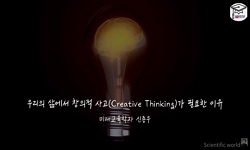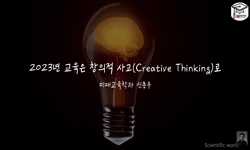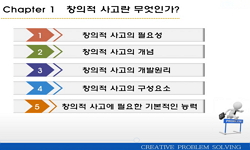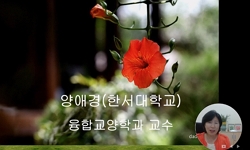Current classrooms in Korea could be characterized as classroom for college entrance test, single-subject oriented classroom where intercommunication with other subjects does not occur, and teacher-oriented one-sided classroom where the communication ...
http://chineseinput.net/에서 pinyin(병음)방식으로 중국어를 변환할 수 있습니다.
변환된 중국어를 복사하여 사용하시면 됩니다.
- 中文 을 입력하시려면 zhongwen을 입력하시고 space를누르시면됩니다.
- 北京 을 입력하시려면 beijing을 입력하시고 space를 누르시면 됩니다.

창의성 신장을 위한 교과융합 프로그램 개발 및 실행 사례 연구 = Development of an Amalgamative-Subject Program for Improving Middle School Students' Creativity and a Case Study on Practicing the Program
한글로보기https://www.riss.kr/link?id=A104048433
- 저자
- 발행기관
- 학술지명
- 권호사항
-
발행연도
2010
-
작성언어
Korean
- 주제어
-
등재정보
KCI등재
-
자료형태
학술저널
-
수록면
129-146(18쪽)
-
KCI 피인용횟수
13
- 제공처
-
0
상세조회 -
0
다운로드
부가정보
다국어 초록 (Multilingual Abstract)
Amalgamative-subject program which enables 10 subjects to intercommunicate each other with the topic of 'space' and 'person' was developed. The study found that the amalgamative-subject program could produce students' creative learning outcomes.
Current classrooms in Korea could be characterized as classroom for college entrance test, single-subject oriented classroom where intercommunication with other subjects does not occur, and teacher-oriented one-sided classroom where the communication between teacher and students does not occur frequently. There are some difficulties to expect students' creativity increase in current type of classroom. Students' creativity is expected to increase through the 'amalgamative-subject' classroom. The study aims to increase students' creativity through developing amalgamative-subject program and practicing the program in classrooms. The study developed amalgamative-subject program and practiced the program to the whole students at Hongik university girl's middle school in 2009. Some evaluation specialist evaluated the program practicing results using evaluation indicators which were developed by the evaluation specialists.
Amalgamative-subject program which enables 10 subjects to intercommunicate each other with the topic of 'space' and 'person' was developed. The study found that the amalgamative-subject program could produce students' creative learning outcomes.
국문 초록 (Abstract)
현재의 교실 수업은 입시중심 교실 수업, 교과 간 단절 상태의 단일 교과 중심 교실 수업, 학생과의 소통이 대체로 적은 교사 측의 일 방향 진행 수업의 형태로 특징지을 수 있으며, 이러한 ...
현재의 교실 수업은 입시중심 교실 수업, 교과 간 단절 상태의 단일 교과 중심 교실 수업, 학생과의 소통이 대체로 적은 교사 측의 일 방향 진행 수업의 형태로 특징지을 수 있으며, 이러한 형태의 수업으로는 학생들의 창의성 신장을 기대하는 데에 많은 한계가 있다. 창의성은 교과 간의 융합적 수업을 통해서도 신장시킬 수 있을 것으로 기대된다. 이 사례 연구의 목적은 교과융합 프로그램을 개발하고 실행함으로써 학생들의 창의성 신장을 도모하기 위함이다. 이 연구에서는 창의성 신장을 위한 교과융합 프로그램을 개발하였고, 홍익대학교 사범대학 부속여자중학교 전교생을 대상으로 2009학년도 1년 동안 교과융합 프로그램을 실행하였다. 프로그램 실행 결과에 대해서는 외부 평가위원들이 개발한 평가 지표를 이용하여 평가를 실시하였다. ‘공간’과 ‘인물’이라는 공통 주제를 가지고 10개 교과의 교과융합이 가능하도록 교과융합 프로그램을 개발하였고, 개발된 교과융합 프로그램 실시 결과 학생들의 창의적인 교육 성과물이 산출되어 교과융합 프로그램을 통하여 창의적인 학습 성과를 얻을 수 있음을 확인하였다.
참고문헌 (Reference)
1 이종연, "창의적 문제해결력 증진을 위한 Creative Thinker 프로그램 연구" 한국교육학술정보원 2005
2 김영채, "창의적 문제해결: 창의력 이론, 개발과 수업" 교육과학사 1999
3 고기혁, "창의적 교수법을 통한 중학교 역사수업이 학생들의 태도와 탐구 능력에 미치는 영향" 서강대학교 대학원 2008
4 정종진, "창의성의 본질과 교과를 통한 창의성 교육" 대구대학교 초등교육연구원 2002
5 권영호, "창의성을 기르는 국어과 수업의 실제" 2005
6 정황순, "창의성 프로그램 개발 적용이 창의성, 정서지능 및 다중지능에 미치는 효과" 원광대학교 대학원 2010
7 최윤정, "창의성 신장을 위한 영어과 자료 활용의 실제" 2007
8 이기중, "창의성 신장 프로그램의 훈련 효과에 대한 메타 분석" 경남대학교 대학원 2004
9 서혜애, "창의성 계발교육의 실태와 전략 수립" 한국교육개발원 2001
10 한국교육개발원, "창의성 계발 교육 실태 분석 및 전략 구안" 한국교육개발원 2001
1 이종연, "창의적 문제해결력 증진을 위한 Creative Thinker 프로그램 연구" 한국교육학술정보원 2005
2 김영채, "창의적 문제해결: 창의력 이론, 개발과 수업" 교육과학사 1999
3 고기혁, "창의적 교수법을 통한 중학교 역사수업이 학생들의 태도와 탐구 능력에 미치는 영향" 서강대학교 대학원 2008
4 정종진, "창의성의 본질과 교과를 통한 창의성 교육" 대구대학교 초등교육연구원 2002
5 권영호, "창의성을 기르는 국어과 수업의 실제" 2005
6 정황순, "창의성 프로그램 개발 적용이 창의성, 정서지능 및 다중지능에 미치는 효과" 원광대학교 대학원 2010
7 최윤정, "창의성 신장을 위한 영어과 자료 활용의 실제" 2007
8 이기중, "창의성 신장 프로그램의 훈련 효과에 대한 메타 분석" 경남대학교 대학원 2004
9 서혜애, "창의성 계발교육의 실태와 전략 수립" 한국교육개발원 2001
10 한국교육개발원, "창의성 계발 교육 실태 분석 및 전략 구안" 한국교육개발원 2001
11 정범모, "창의력이란" 교육과학사 2005
12 김창환, "언어적 창의성 신장 프로그램이 언어 능력과 인지․정의적 창의성에 미치는 효과" 전주대학교 대학원 2007
13 가은영, "시각적 사고력 계발 프로그램 운영을 통한 창의력 신장" 한국교원대학교 대학원 2004
14 김상복, "사회과 창의력 신장을 돕는 교수ㆍ학습 지도사례" 2005
15 전경원, "브레인스토밍에 관한 문헌적 고찰" 1 (1): 29-64, 1997
16 이수원, "밥 파이크의 창의적 교수법에 관한 고찰" 11 : 165-180, 2004
17 밥 파이크, "밥 파이크의 창의적 교수법" 김영사 2006
18 정옥분, "‘청소년의 힘 북돋우기 프로그램’의 개발과 효과연구고를 통한 중학교 기술·가정 교과의 ‘나와 가족의 이해’ 단원 학습" 한국가정과교육학회 17 (17): 17-33, 2005
19 Rose, L. H., "The meta-analysis of long-term creativity training programs" 18 : 11-22, 1984
20 Sternberg, R., "The concept of creativity: prospects and paradigms. in: ook of creativity" Cambridge University Press 1999
21 De Bond, E., "Six thinking bats" Little Brown 1985
22 Torrance, E. P., "Making the creative leap beyond" Creative Education Press 1999
23 Covington, M. V., "Facilitation of creative problem solving" 4 : 3-5, 1965
24 Romina, M. J., "Enhancing elementary student's creative problem solving through project-based education" Australia Queensland 2001
25 Feldhusen, J. F., "Creative thinking and problem solving in gifted education dubuque" Kendall Hunt 1986
26 Parnes, S., "Creative behavior guidebook" Scribner 1967
27 Parkhurst, H. B., "Confusion, lack of consenus, and the definition of creativity as a construct" 33 : 1-21, 1999
28 Osborn, A., "Applied imagination: principies and procedures of creative thinking" Cribner's 1963
동일학술지(권/호) 다른 논문
-
초등학교 고학년 아동의 스트레스 대처능력 향상을 위한 NLP 집단상담 프로그램 개발
- 한국교원대학교 교육연구원
- 박정연
- 2010
- KCI등재
-
과학자의 연구과정을 가시화한 학습 프로그램이 고등학교 1학년 학생들의 진로지향에 미치는 영향
- 한국교원대학교 교육연구원
- 신호심
- 2010
- KCI등재
-
가정통신문을 활용한 양성평등교육의 효과 - 부산시 S초등학교의 사례를 중심으로-
- 한국교원대학교 교육연구원
- 이언숙
- 2010
- KCI등재
-
초등학생의 인터넷 사용과 자기효능감 및 자기통제력과의 관계
- 한국교원대학교 교육연구원
- 이병환
- 2010
- KCI등재
분석정보
인용정보 인용지수 설명보기
학술지 이력
| 연월일 | 이력구분 | 이력상세 | 등재구분 |
|---|---|---|---|
| 2026 | 평가예정 | 재인증평가 신청대상 (재인증) | |
| 2020-01-01 | 평가 | 등재학술지 유지 (재인증) |  |
| 2017-01-01 | 평가 | 등재학술지 유지 (계속평가) |  |
| 2013-01-01 | 평가 | 등재학술지 유지 (등재유지) |  |
| 2010-06-03 | 학술지명변경 | 외국어명 : 미등록 -> Korean Journal of Teacher Education |  |
| 2010-01-01 | 평가 | 등재학술지 선정 (등재후보2차) |  |
| 2009-01-01 | 평가 | 등재후보 1차 PASS (등재후보1차) |  |
| 2007-01-01 | 평가 | 등재후보학술지 선정 (신규평가) |  |
학술지 인용정보
| 기준연도 | WOS-KCI 통합IF(2년) | KCIF(2년) | KCIF(3년) |
|---|---|---|---|
| 2016 | 1.21 | 1.21 | 1.23 |
| KCIF(4년) | KCIF(5년) | 중심성지수(3년) | 즉시성지수 |
| 1.09 | 1.03 | 1.544 | 0.52 |




 스콜라
스콜라






